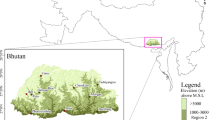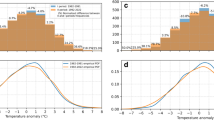Abstract
Based on daily minimum temperature data during 1979–2013, the frequency of occurrence,the beginning date and ending date and other characteristic values of cold waves at all levels are processed. Then, by using the method of Mann–Kendall method, correlation analysis, empirical orthogonal function and Morlet wavelet analysis, the spatiotemporal distribution and inter-annual variation and other characteristics of cold wave, strong cold wave and ultra-strong cold wave of Shandong Province are analyzed. The tendency of cold waves at all levels in Shandong Province is predicted for the coming years, which might be referable in the prevention of cold wave and storm surge disaster.


















Similar content being viewed by others
References
Barnett AG, Hajat S, Gasparrini A, Rocklöv J (2012) Cold and heat waves in the United States. Environ Res 112(1):218–224
Cattiaux J, Douville H, Riles A, Chauvin F, Plante C (2013) Towards a better understanding of changes in wintertime cold extremes over Europe: a pilot study with CNRM and IPSL atmospheric models. Clim Dyn 40(9):2433–2445
Chen YS, Yi QJ, Mou WF (1974) Some discussions on the classification criteria of cold air. Meteorol Monthly 1:7–10 (in Chinese)
Chen YY, Chen N, Ma JR, Chen XJ (2010) Variety of Ningxia cold waves in the last 48 years and its possible reasons. J Nat Res 25(6):939–951 (in Chinese)
CMA (China Meteorological Administration) (2008) Grades of cold wave (GB/T 21987-2008). Standards Press of China, Beijing
Dong GH, Ma YX, Ma XZ (2008a) Cross-shore variations of wave groupiness by wavelet transform. Ocean Eng 35(7):676–684
Dong GH, Ma YX, Perlin M, Ma XZ, Yu B, Xu JW (2008b) Experimental study of wave–wave nonlinear interactions using the wavelet-based bicoherence. Coast Eng 55(9):741–752
Duan LY, Liu AX, Yu LL (2013) Temporal and spatial distribution of cold wave and its variation around the Bohai Sea region from 1961 to 2010. J Meteorol Environ 29(4):54–58 (in Chinese)
Farge M (1992) Wavelet transforms and their applications to turbulence. Annu Rev Fluid Mech 24(1):395–458
Gao ST, Tao SY, Ding YH (1992) Upper wave-east Asian jet interaction during the period of cold wave outbreak. Chin J Atmos Sci 16(6):718–724 (in Chinese)
Gunter G, Hildebrand HH (1951) Destruction of fishes and other organisms on the South Texas coast by the cold wave of January 28–February 3, 1951. Ecology 32(4):731–736
Kodra E, Steinhaeuser K, Ganguly AR (2011) Persisting cold extremes under 21st-century warming scenarios. Geophys Res Lett 38:L08705
Lee WV (2014) Historical global analysis of occurrences and human casualty of extreme temperature events (ETEs). Nat Hazards 70(2):1453–1505
Liu Y, Qiu YY (1992) A case study of cold wave in East Asia using trajectory techniques. Acta Meteorol Sin 50(1):60–71
Liu XF, Zhu XF, Pan YZ, Zhao AZ, Li YZ (2015a) Spatiotemporal changes of cold surges in Inner Mongolia between 1960 and 2012. J Geog Sci 25(3):259–273
Liu W, Huang SY, Li D, Wang CY, Zhou X, Chen SS (2015b) Spatiotemporal computing of cold wave characteristic in recent 52 years: a case study in Guangdong Province. South China. Nat Hazards 79(2):1257–1274
Lu W (1936) The cold waves of China. Acta Meteorologica Sinica 12(12):651–679
Lu GM, Yao JS, Tao ZY (1983) The dynamical cause of the cold dome’s intensification in the cold outbreak process. Acta Meteorol Sin 41(4):393–403
Ma XQ, Ding YH, Xu HM, He JH (2008) The relation between strong cold waves and low-frequency waves during the winter of 2004/2005. Chin J Atmos Sci 32(2):380–394 (in Chinese)
Ma YX, Dong GH, Ma XZ (2011) Separation of obliquely incident and reflected irregular waves by the Morlet wavelet transform. Coast Eng 58(8):761–766
Mann HB (1945) Nonparametric tests against trend. Econometrica 13(3):245–259
Meng XJ, Wu ZF, Du HB, Wang L (2013) Spatio-temporal characteristics of cold wave over northeast China during 1961–2010. J Arid Lang Res Environ 27(1):142–147 (in Chinese)
Mori N, Yasuda T (1994) Orthonormal wavelet anal-ysis for deep-water breaking waves. In: Proceedings of the 24th international conference on coastal engineering, October 23–28, 1994 Kobe, Japan. pp 412–426
Qiu YY (1957) An investigation of the structure of the cold front and the upper horizontal temperature field in a case of cold air outbreak. Acta Meteorol Sin 28(1):13–26
Qiu YY, Zhao QG (1983) Barotropic energy conversion before and after the cold wave in October 1978 and seasonal transition. Acta Meteorol Sin 41(2):159–166
Song X, Zhang Z, Chen Y, Wang P, Xiang M, Shi PJ, Tao FL (2014) Spatiotemporal changes of global extreme temperature events (ETEs) since 1981 and the meteorological causes. Nat Hazards 70(2):975–994
Tao SY (1957) A synoptic and aerological study on a cold wave in the Far East during the period of the break down of the blocking situation over Euroasia and Atlantic. Acta Meteorol Sin 28(1):63–74
Torrence C, Compo GP (1998) A practical guide to wavelet analysis. Bull Am Meteorol Soc 79(1):61–78
Varfi MS, Karacostas TS, Makrogiannis TJ, Flocas AA (2009) Characteristics of the extreme warm and cold days over Greece. Adv Geosci 20:45–50
Wang ZY, Ding YH (2006) Climate change of the cold wave frequency of China in the last 53 years and the possible reasons. Chin J Atmos Sci 30(6):1068–1076 (in Chinese)
Wu KJ, Song JB, Lou SL (1998) Fluctuations of peak energy and peak frequency of local wavelet energy spectrum for wind waves. Acta Oceanol Sin 20(3):1–5
Xu AH, Qiao L, Zhan FX, Niu XQ (2006) Diagnosis of a cold wave weather event in March 2005. Meteorol Mon 32(3):49–55 (in Chinese)
Zhang PZ, Chen GM (1999) A statistical analysis of the cold wave high which influences on China. Acta Meteorol Sin 57(4):493–501
Zhang H, Shi JE (1957) The Activity of the anticyclone in Eastern Asia. Acta Meteorologica Sinica 28(3):167–174
Zhao P, Jiang WS (2011) A numerical study of storm surges caused by cold-air outbreaks in the Bohai Sea. Nat Hazards 59(1):1–15
Acknowledgements
This work is funded by the National Key Research and Development Program, China (Nos. 2016YFC0303401, 2016YFC0802301), the National Natural Science Foundation of China (Nos. 51479183, 51509227), and the Shandong Province Natural Science Foundation, China (No. ZR2014EEQ030).
Author information
Authors and Affiliations
Corresponding author
Rights and permissions
About this article
Cite this article
Dong, S., Huang, W., Li, X. et al. Study on temporal and spatial characteristics of cold waves in Shandong Province of China. Nat Hazards 88, 191–219 (2017). https://doi.org/10.1007/s11069-017-2862-y
Received:
Accepted:
Published:
Issue Date:
DOI: https://doi.org/10.1007/s11069-017-2862-y




